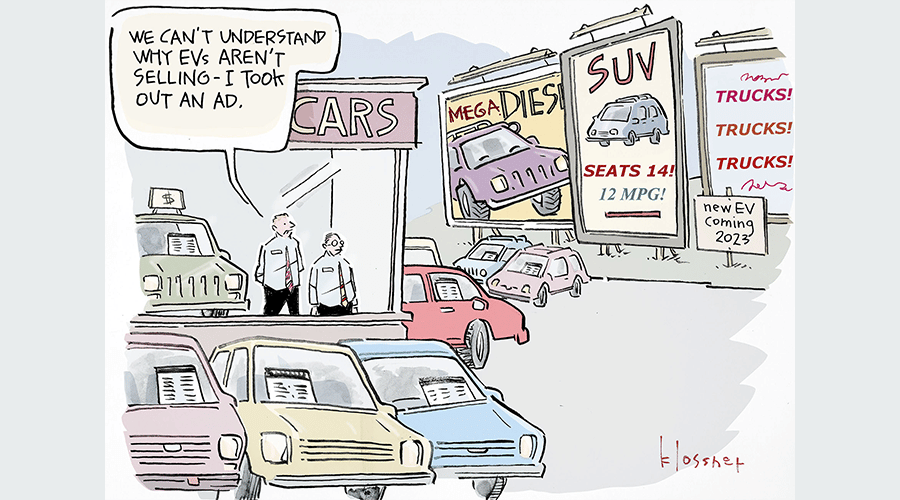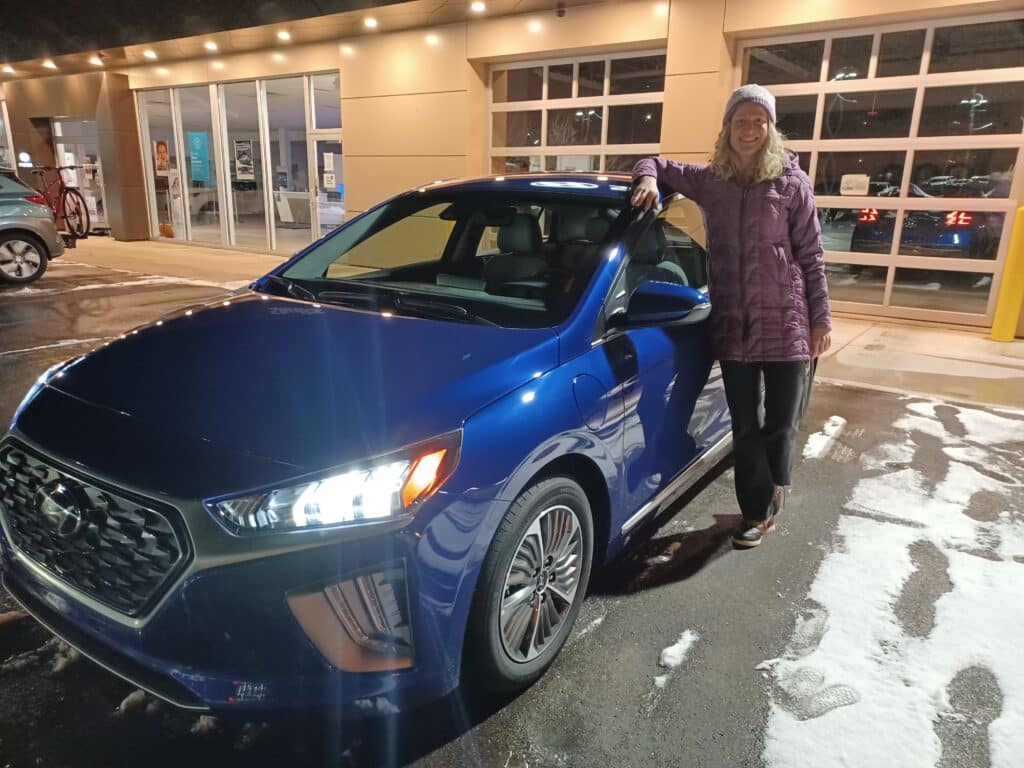Electric vehicles seem to be having their moment. Seven out of nine star-studded car commercials during this year’s Super Bowl advertised EVs. Sales of EVs in 2021 soared even as the auto industry struggled to produce gas-powered cars. And major automakers have committed to adding more EVs to their fleets over the next decade.
These are promising signs. The Biden Administration set a goal to ensure that half of all new cars sold in 2030 are zero-emissions cars. The Rocky Mountain Institute estimates that the total EVs on U.S. roads will need to number 40 to 50 million by 2030 in order to align with the country’s climate goals. With all of this momentum, the market will surely take it from here and get us there, won’t it? We don’t need subsidies anymore nor do we need to keep spreading the word about why we need an EV revolution, right?
Wrong.
The truth is the market will not take it from here alone. Automakers are still making and selling more gas-powered cars than they are battery-powered EVs. Electric cars make up less than 1% of the 250 million cars, SUVs, and light-duty trucks on the road today in the United States. And automakers still spend way more money advertising combustion-engine cars than they do on advertising EVs. In 2021, the auto industry spent $248 million on advertising EVs and plug-in hybrids compared to the $3.1 BILLION (with a B) it spent on traditional gas-powered cars.

Most Americans don’t even know that some automakers make EVs. Even in California, which has the largest electric car market in the country, awareness of EVs remains low. Let’s not forget about the active push against policies that promote electric vehicles around the country. Some legislators in Virginia, for example, tried to repeal clean car standards just this year.
So while it may seem as if EV awareness and adoption are growing, it’s not growing as rapidly as we need it to. The decisive decade is no longer a decade. The urgency of the climate crisis demands that we move away from our dependence on fossil fuels in the next eight years before the changes cause irreversible harm. We don’t have time to wait for a slow adoption of EVs.
To drive a true EV revolution, we need to overcome remaining challenges, from affordability to infrastructure. We all have unique roles to play to solve these hurdles.
The collective work ahead
According to Pew Research Center, roughly 67% of Americans say that electric cars and trucks are better for the environment compared with gas-powered vehicles. But 66% of Americans also perceive electric vehicles to be more expensive. These days with a growing number of options, the price of EVs is narrowing and comparable to the price of many gas-powered cars.
Low-income households spend a larger percentage of their income on transportation costs and are affected disproportionately by car pollution. They stand to benefit the most from the clean air and from saving money on transportation.
And governments at all levels – local, state, and federal – still have a major role to play in breaking down these barriers. They need to build on clean car standards and continue to offer tax credits and other incentives to make EVs accessible and affordable to more people beyond those who earn middle to high incomes.
This is how other countries around the world have gotten ahead of the United States with more EVs on their roads. Governments around the world have put in place policies and offered massive subsidies that encourage the switch to electric vehicles.
China, for example, is planning to cut back its subsidies but is requiring carmakers to sell a certain percentage of electric vehicles or face monetary penalties. European countries, such as France and Spain, are also offering deep subsidies and tax credits to encourage people to replace their old gas-powered cars with EVs.
Governments, utilities, and power generators also need to deeply invest in building a robust charging network and modernizing the energy grid. The Biden Administration plans to use $5 billion from the infrastructure law to build a network of EV chargers. And many utility companies already offer cash rebates so that EV owners can install level 2 chargers at home. Others offer rewards programs for charging EVs during off-peak hours. This kind of support needs to continue.
Another perceived hurdle to overcome is people’s fear about running out of battery power. The truth is that almost all EV’s on the market today offer more than 250 miles of range, and the average American only drives 39 miles per day—that means you could make it through your entire work week without needing a charge. Charging an EV can be much easier than filling up a gasoline-powered car as the majority of charging happens at home. And battery technology continues to improve. The range of EVs has increased 15% over the last few years, and it’s bound to keep increasing. The auto industry plans to invest half a trillion dollars in EVs and batteries.
This is where nonprofit advocacy organizations like us come in. We need to continue raising awareness about EVs, addressing misconceptions, and advocating for their widespread adoption through education campaigns.
How you can help
While most Americans are very concerned about climate change, they aren’t driving like it. Personal cars make up 60% of transportation-related greenhouse gas emissions – that’s one-third of all emissions contributing to climate change. Last year alone, fifteen million Americans bought a new car or truck and only 3% of those were fully electric.
If you are serious about doing something about climate change, then switching to an electric car, especially if you were already planning to buy a new car, is something you can do today to make a difference. If you can’t purchase a car now, take the pledge to make the next car you do purchase an electric one.
If you already own an EV, share your experience with family, friends and co-workers. Word-of-mouth has the biggest impact on what vehicle people buy (yes, even more than those fancy Super Bowl ads). Tell them about which federal and state incentives you took advantage of and how much money you expect to save. Give them a lift in your EV and show them how fun and safe they are to drive. Even just riding in the passenger seat of an electric vehicle makes someone three times more likely to consider purchasing one in the future.
Importantly, tell your legislature to continue to offer incentives and pass policies that promote an EV revolution (and protect the policies that already are in place). Being a clean energy voter also means being a clean car voter.
In the end, this is still an “all-hands-on-deck” effort to get more electric vehicles on the road, and more gas-guzzling polluting cars off the road. We should capitalize on the momentum that EVs are having to propel them into a full-throated adoption nationwide.















